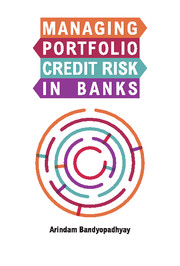Book contents
- Frontmatter
- Dedication
- Contents
- Tables, Figures, Charts
- Preface
- Acknowledgements
- Abbreviations
- 1 Introduction to Credit Risk
- 2 Credit Rating Models
- 3 Approaches for Measuring Probability of Default (PD)
- 4 Exposure at Default (EAD) and Loss Given Default (LGD)
- 5 Validation and Stress Testing of Credit Risk Models
- 6 Portfolio Assessment of Credit Risk: Default Correlation, Asset Correlation and Loss Estimation
- 7 Economic Capital and RAROC
- 8 Basel II IRB Approach of Measuring Credit Risk Regulatory Capital
- Index
8 - Basel II IRB Approach of Measuring Credit Risk Regulatory Capital
Published online by Cambridge University Press: 05 May 2016
- Frontmatter
- Dedication
- Contents
- Tables, Figures, Charts
- Preface
- Acknowledgements
- Abbreviations
- 1 Introduction to Credit Risk
- 2 Credit Rating Models
- 3 Approaches for Measuring Probability of Default (PD)
- 4 Exposure at Default (EAD) and Loss Given Default (LGD)
- 5 Validation and Stress Testing of Credit Risk Models
- 6 Portfolio Assessment of Credit Risk: Default Correlation, Asset Correlation and Loss Estimation
- 7 Economic Capital and RAROC
- 8 Basel II IRB Approach of Measuring Credit Risk Regulatory Capital
- Index
Summary
The Basel Committee on Banking Supervision (BCBS) issued its revised framework on “International Convergence of Capital Measurement and Capital Standards” in June 2006. This Basel II capital norm intends to foster a strong emphasis on risk management practices and encourage the ongoing improvements in banks' internal risk assessment capabilities. The Reserve Bank of India released its Revised Draft Guidelines for implementation of the New Capital Adequacy Framework (NCAF) in April, 2007. Following the release of RBI NCAF guidelines, Indian banks started implementing the Basel II regulatory norms. First, Indian banks with overseas presence and branches of foreign banks in India implemented the Basel II standardized approach for credit risk on 31 March 2008. The other banks were also in the Basel II regime by March end 2009. Indian banks were encouraged to maintain, at both solo and consolidated level, a Tier I CRAR of at least 6 per cent. Banks which were below this level were asked to achieve this ratio on or before 31 March 2010. The purpose of the Basel II framework was to ensure that the minimum levels of capital are held by internationally active banks against their exposures to ensure solvency and financial stability.
The revised capital rules, especially the codifications of the Basel II IRB Formulations, represent a dramatic change as compared to Basel I and Basel II Standardized Approach. The new regulations recognize the advances in the science of credit risk management and provide incentives by allowing users of more sophisticated credit risk management techniques. Basel II is designed to extend and refine the regulatory approach outlined in Basel I used in measuring credit and operational risk. Its main goals are:
• to maintain the current level of capital in the financial system while creating incentives for a risk-sensitive management and
• to reduce the possibility for regulatory capital arbitrage (cherry picking by banks-incentive to minimize their capital cost by applying approach with least capital cost for each single exposure in their loan portfolio).
As a member of G20, the Reserve Bank of India (RBI) has now also issued final norms for Basel II IRB migration in December 2011. The RBI in its Basel II IRB guidelines has advised the banks intending to move to IRB approaches for credit risk to assess their preparedness for the same with reference to the guidelines.
- Type
- Chapter
- Information
- Managing Portfolio Credit Risk in Banks , pp. 318 - 354Publisher: Cambridge University PressPrint publication year: 2016
- 1
- Cited by



